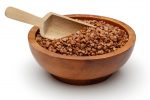Grains are of increasing interest to the public at large having moved from the preserve of the foodie to a more mainstream audience. We are always on the look out for new grains for our bread formulations, so when some-one recommended trying out farro, I thought – lets give it a whirl.
Farro should be better known. We all know about common whole grains like barley, oats, wheat and quinoa but when it comes to rarer grains then you know you might find something unique. Farro is a type of wheat so don’t expect to see gluten-free with this grain. It looks more like a barley grain which is substantially more rectangular. It also tastes similar to barley which might reflect some ancient lineage. Treat it as an ancient grain anyway !
When you prepare meal using farro it’s noticeable how chewy it is when cooked but thankfully not soft or mushy. That means it works well in foods which need some bite or substance to them. A puri for example made with this wheat seems firmer and requiring more mastication. It certainly does not taste like rice which some have compared it to and we find it could actually replace barley in some bread mixes.
Farro comes in a variety of formats – whole grain, semi-pearled and pearled. There are some great recipes to be tried especially those replacing barley.
Cooking With Farro
Farro is cooked like most grains in a rice cooker, pressure cooker or as part of a granola by baking. We soak our farro overnight to soften the texture and reduce cooking time. A minimum of 30 minutes is needed if soaking is the preferred route. When it comes to adding water, do 2.5 cups of water to every one cup of grain. A stock can be tried if the farro is intended for soups and broths.
In the process of cooking farro, bring the water to the boil, add the farro and cover. It takes about 30 minutes or 20 minutes if the grains has been steeped overnight. Check for texture by squeezing the grain between finger and thumb and checking for a slightly grainy, yielding feel. You know you have probably gone too far it the grain smears too easily between the fingers although some applications will need a softer texture.
Purchasing Farro
In the UK, farro is currently available in whole food shops, certainly not the ordinary supermarket. In the USA, it tends to be sold in the pearled form so less cooking time is required compared to the other formats of unpearled or semi-pearled. In Europe, all three types are available.
Nutritional value
Farro like many whole grains are super sources of iron and of course, fiber.
A quarter cup of the uncooked farro contains:
- Calories: 200
- Calories from fat: 15
- Total fat: 1.5g (no saturated, trans fat or cholesterol)
- Sodium and potassium are both 0mg
- Total carbohydrate: 37g
- Dietary fiber: 7g
- Sugars: 0g
- Protein: 7g
- No vitamins such as A or C
- Calcium: 2 percent of daily allowance
- Iron: 10 percent of daily allowance


Leave a Reply